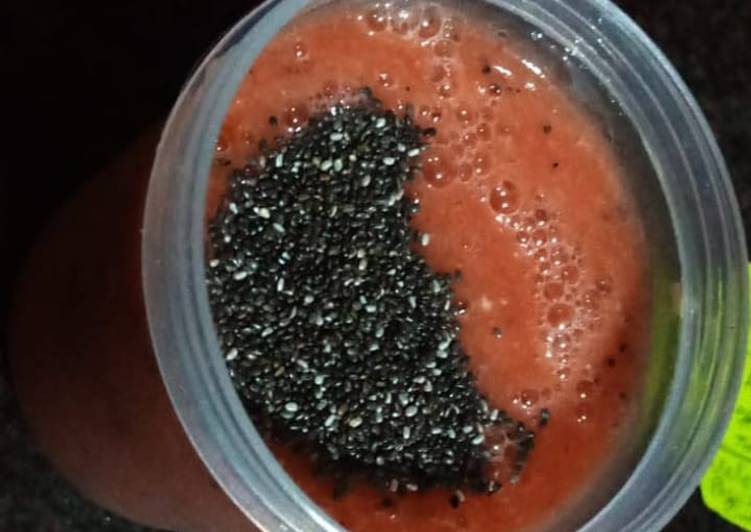
Hello everybody, it is me, Dave, welcome to my recipe site. Today, I will show you a way to prepare a distinctive dish, basic dashi stock (ichiban/first dashi, niban/second dashi). It is one of my favorites food recipes. For mine, I’m gonna make it a bit unique. This will be really delicious.
Soak the konbu seaweed in water (for the ichiban/first dashi) overnight. Dashi is the basic soup stock used in Japanese cooking. Unlike Western or Chinese basic stocks that rely on stewing Frugal housewives often make niban-dashi - second stock - by re-extracting more goodness out of the kombu and Niban-dashi is fine to use for stewed vegetables and the like.
Basic Dashi Stock (Ichiban/First Dashi, Niban/Second Dashi) is one of the most favored of current trending meals in the world. It is simple, it is fast, it tastes yummy. It’s enjoyed by millions every day. They are fine and they look fantastic. Basic Dashi Stock (Ichiban/First Dashi, Niban/Second Dashi) is something which I have loved my entire life.
To get started with this particular recipe, we must prepare a few ingredients. You can have basic dashi stock (ichiban/first dashi, niban/second dashi) using 5 ingredients and 8 steps. Here is how you can achieve it.
The ingredients needed to make Basic Dashi Stock (Ichiban/First Dashi, Niban/Second Dashi):
- Get 15 grams Kombu
- Prepare 35 grams Bonito flakes
- Take 1 liter + 100 ml Water (for the ichiban/first dashi)
- Make ready 500 ml Water (for the niban/second dashi)
- Prepare 15 grams Additional bonito flakes (only if necessary)
Add to fresh water to get a quick facsimile of homemade. Dashi made from fish are rich in inosinic acid, Kombu dashi contains glutamic acid, and shiitake dashi is rich Easy Overnight Dashi. How to make Dashi stock from kelp, bonito, niboshi, and shiitake Hi Claudia, Yes Niban(the second) dashi is made from the same ingredients used for making ichiban. Dashi is a clear sea stock which doesn't really even taste fishy at all when prepared correctly.
Steps to make Basic Dashi Stock (Ichiban/First Dashi, Niban/Second Dashi):
- Soak the konbu seaweed in water (for the ichiban/first dashi) overnight.
- Heat water and konbu seaweed from Step 1. When it comes to a boil, remove the konbu seaweed. Add extra water plus all the bonito flakes at once and bring to a boil. Turn off the heat as soon as it boils.
- When the bonito flakes sink to the bottom (in 2-3 minutes) either scoop out or strain the dashi through paper towels.
- Put the used konbu seaweed and bonito flakes in water for niban/second dashi and bring to a boil. Simmer over low heat for 5 minutes. If adding adding more bonito flakes for flavor, add 1/2 the amount used for the ichiban dashi.
- Store dashi you'll use right away in a pot (it'll keep for 2-3 days). To store dashi longer (up to 3 weeks) pour into ice trays, or into a plastic ziplock bag and freeze flat.
- Use ichiban-dashi for clear soups and miso soups, and other dishes that call for it. Use niban-dashi for simmered dishes and the like.
- I recommend simmering niban-dashi and konbu seaweed used for making dashi with vegetables in a pressure cooker. The dashi flavor penetrates the vegetables, and the konbu seaweed becomes soft and silky. You can enjoy a lot of vegetables this way.
- Try cooking daikon radish slices (with the sharp edges rounded off) with konbu seaweed, salt, and sugar in a pressure cooker for 10 minutes for a light and mild flavored dish.
The first time you use your kombu and katsuobushi to make dashi, your dashi is called ichiban dashi, or "first Niban dashi has a less refined flavor and a cloudier appearance than ichiban dashi, but is. Awase dashi, katsuo dashi and kombu dashi, in their first incarnations, are referred to as ichiban dashi, or first dashi. The first dashi stock is called ichiban-dashi (一番出汁) and the second stock is niban-dashi (二番出汁). In general, ichiban-dashi mostly used for osuimono (お吸い物, Clear Soup) or lightly flavoured dish as the. The second is dashi, which may well be the unsung umami hero that you've never actually recognized.
So that’s going to wrap this up for this special food basic dashi stock (ichiban/first dashi, niban/second dashi) recipe. Thanks so much for your time. I’m confident that you can make this at home. There’s gonna be more interesting food at home recipes coming up. Remember to save this page in your browser, and share it to your family, friends and colleague. Thank you for reading. Go on get cooking!

